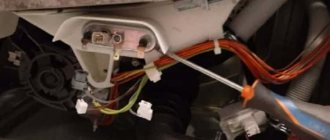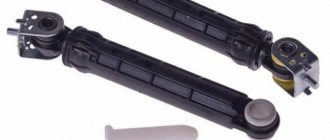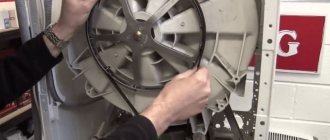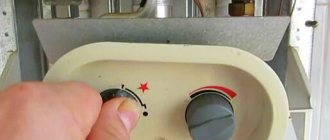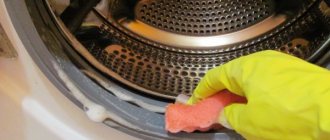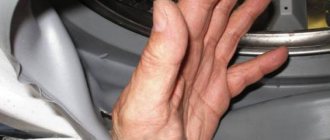Why does the drum rotate poorly?
In such a situation, you should definitely be concerned about the reasons for the breakdown. Based on this, the most suitable methods of repair work will be assigned. Often problems with element rotation include the following:
- Overload. Many modern washing machines that have special sensors do not start the process if there are too many items in the drum. When you suspect that you have overloaded the machine, it is recommended to cancel the program and take out a couple of things. This measure will allow the machine to continue operating as usual.
- Worn drive belt. In such a situation, rotation of the drum will only be possible by hand; the electric motor will not do this. However, the belt might not wear out, but simply fly off from the landing site.
- Electric motor brushes are worn out. In washing machines with commutator electric motors, this place is the most vulnerable. If the required motor maintenance has been performed over the entire period of operation, then there is a possibility that the brushes will have to be replaced. As a rule, after such a procedure, the machine’s ability to work is fully restored.
- The electronic programmer has failed. The most complex breakdown, because the work of reflashing or replacing the modular unit will require certain financial expenses.
- The electric motor is malfunctioning. When the drum rotates unevenly or does not rotate at all, the problem may lie in the electric motor. It probably broke, or a short circuit occurred - more likely problems in this situation. The repair is complex; it is recommended to hire an experienced specialist.
Let's check the motor brushes
If, after examining the engine brushes, you find that they are worn out, it is better to replace the elements. To choose the right brushes for the electric motor, you need to know the type and model of your washing machine’s engine. This data can be obtained by examining the markings on the electric motor.
The algorithm for replacing brushes is quite simple; you need to remove the old elements from the motor and install new components, securing them with bolts. After installing the brushes, rotate the engine by hand to understand the tightness of their fit to the engine.
When rotating, the device should make a slight clicking sound.
We figure out the problem ourselves
Primary diagnosis of breakdowns will be within the capabilities of any user. To do this, you must follow certain procedures:
- check the maximum weight of the laundry in the operating instructions;
- check that the door is not locked. As a rule, the drum stops spinning if the water drain filter is clogged;
- We try to turn the drum with our hands. If everything is normal, and a problem is observed during the automatic washing process, you should look for the cause in the wires, tachogenerator device, control module;
- It is imperative to inspect the cavity between the machine tank and the drum for the presence of foreign objects. If everything is normal, the heating element may have failed. The drum may also stop rotating due to a non-working heating element, thereby completely blocking the washing process;
- inspect the drive belt. It should be corrected or completely replaced with a new analogue;
- The machine is disassembled and inspected to see if there are any problems with the bearings. It is quite possible that they also need to be replaced.
How to fix it yourself
If for some reason you cannot call a technician, you will have to be patient, since it is unlikely that you will be able to quickly fix the problem. It is necessary to understand the technical device. For this, the instructions from the LG, Samsung or Indesit washing machine will be useful.
Replacing the heating element
What can be done to make the drum of the machine work as before?
- Replace some parts (brushes or belt).
- Replace the heating element.
- Remove foreign object.
We carry out repairs
Let's consider how to act in a given situation:
- A foreign object has entered. Such situations arise quite often when we forget to check our pockets before washing. All small items in most cases remain in the drum itself or the sealing element surrounding the loading door. Sometimes, during washing, such items fall into the gaps created by the drum and tank of the machine and get stuck there, becoming an obstacle to normal rotation. This suspicion is verified quite simply. First we try to rotate the drum manually. If it stands still, it means it is fixed by some thing or foreign object. To find out their location in relation to the tank, you should slowly rotate the drum with your hands, shining a flashlight into the space. To gain access, you will have to remove the heating element and pull out the foreign object through the resulting niche. Magnets or wire hooks can be a good help for this type of work. The problem is, if something is stuck in the top or side part, you will have to disassemble the tank. This is not the best solution, because then you will have to seal the seams with sealant or cold welding.
- Bearing failure. You cannot turn the drum with your hands, or do it with great difficulty, hearing creaking and grinding noises? Most likely, the problem is hidden in the seals and bearings. The first element is represented by special sealing seals that protect the bearings from moisture. Gradually, its integrity deteriorates, the liquid begins to wash out the lubricant on the bearings, causing corrosion. The breakdown is eliminated by completely replacing the failed elements. The work is complex, it is recommended to invite a specialist. By the way, the process is expensive. For example, on Samsung machines, its cost is such that it is better to purchase a new washing machine.
- The filter is clogged. At such moments, the machine stops in emergency mode, stopping the process and blocking the door. You can clean the filter yourself. The operating instructions describe the procedure in detail. Most often it is located at the bottom. Carefully unscrew the lid, clean the element and drain the remaining water in the machine. Before performing such work, it is recommended to place a sufficient number of rags under the washing machine to absorb any water spilled on the floor.
- The drive belt has fallen off. It is stretched from the drum to the motor, and from long work it stretches, stopping normal torsion. With the unit switched off, you can perform a check - spin the drum. If the movement is free and there is no noise from the electric motor, then it is the belt that is damaged. It often falls off due to uneven loading or overloading of machines, dries out, loses elasticity, and becomes brittle. To check its condition, you can remove one of the side panels of the washer. A belt that has fallen off is installed using the principle of a bicycle chain. If necessary, a new analogue is purchased. The belt is pulled with such force that when you touch it, it should make a ringing sound.
- Motor failure. In older models, the capacitor most often fails - a cylinder installed next to the motor. If it fails, the engine is unable to turn on, and the drum, naturally, also does not rotate. In such a situation, it is necessary to replace the capacitor. A common occurrence is brush wear. Over time, they become short and no longer reach the engine manifold, without transmitting the rotational process to it. The problem is solved by replacing the brushes and first cleaning the commutator from dirt. The motor is dismantled. To do this, remove the back panel and turn the washer on its side. The mounting screws are unscrewed and the terminals with wires are disconnected. After installing the brushes, rotate the motor pulley. If it works without noise, then the job has been done correctly.
- Problem with wires. It is possible that there is no voltage in the wiring. This may happen due to a failure of the control module or a malfunction of the wires powering the electric motor. Each element will have to be checked with a tester, isolated or completely changed.
- Uncontrolled opening of the drum doors occurs. This is typical for models with vertical loading of laundry. The doors swing open even during the washing process, although the design of the elements completely eliminates this possibility. The worst thing is that the tank is destroyed or the drum becomes deformed. Intervention by an experienced specialist is required.
- Failure of the module responsible for control. It is responsible for the performance of each individual washing machine unit. Incorrect operation may cause the drum to stop. You will have to replace the element or try to repair it. This will require knowledge and special skills, otherwise independent actions can only aggravate the problem.
Washing machine drum does not spin
When the drum mechanism rotates weakly, jerkily, or even stops, the cause may be its elementary overload. In other cases, the motor, motor brushes, or software module could fail. Let's consider each case in more detail.
Machine overload
If the automatic machine barely turns during washing, you may simply have overloaded it or the things inside are unevenly distributed. This is the most harmless problem that can be eliminated by taking out unnecessary things.
Don't try to wash everything in one cycle. Consider the capacity of your equipment.
After reducing the load, start the wash program again. If the machine starts working, then the worst is over.
New models of automatic machines - such as Ardo, Whirlpool, LG - are equipped with special sensors. If the load limit is exceeded, an error code will appear on the display or the machine will beep.
Units without sensors simply stop the wash cycle, signaling that a problem has occurred.
Drive belt wear
The drive belt transmits rotation from the engine to the tank. The operation of the device is disrupted if the belt becomes unusable: it stretches, frays or bursts. This can happen during active use or vice versa during prolonged downtime.
The worn part should be replaced with a new one.
Buy a new part with markings like the previous one - it is on the surface. The length of the part, the number and size of wedges are indicated there.
Electric motor brushes worn out
This malfunction most often occurs with outdated models or those that are used frequently. Motor brushes wear out simply due to long periods of use.
They need to be replaced. There shouldn't be any difficulties with this. All you need to do is remove the engine and replace the worn part.
The prices for electric motor brushes are low, so repairs will not be expensive.
If after this the machine begins to make a lot of noise during operation, it means that the brushes were replaced incorrectly.
Engine failure
In this case, the drum mechanism begins to rotate more slowly until it stops completely in the future. In this case, the motor stops making sounds characteristic of its operation. It could be:
- Failure caused by voltage surges or leaks;
- Wear of brushes - this is written above;
- Capacitor failure is typical for older models.
The motor should be carefully inspected and additional diagnostics performed. In the best case, it can be repaired, in the worst, it will need to be completely replaced.
Software module malfunction
The software module that controls almost all the mechanisms of the automatic machine is also susceptible to breakdowns. Due to its wear or voltage drops in the network, the drum device also begins to jam. To eliminate a breakdown in electronically controlled cars, you will have to reset the programs. In models with electromechanical control, the board will need to be re-flashed or completely replaced.
Useful tips from experts
When using a washing machine, it is recommended to follow some important requirements in order to protect the drum and other components from possible damage:
- Always empty your pockets when putting things in the wash;
- load the maximum permitted weight; in case of overload, stop the program to lighten the drum;
- Do not try to forcefully rotate the drum for a long time if it stops working. This is only allowed to be done to check the causes of the breakdown;
- Use descaling products carefully. It is recommended to purchase them only in specialized stores and use them in accordance with the instructions;
- When replacing items that have lost their functionality, purchase only branded analogues that match your markings. Fake parts will not work for a long time and will cause further malfunctions.
By following these simple rules, you can extend the life of your washing machine.
When to contact a specialist?
Sometimes a malfunction of the drum of an Indesit, Samsung or LG washing machine is associated with the main part - the electronic module. You won’t be able to fix this problem yourself if you don’t have the special skills to do it. An unprepared person will not understand the problem, but will only make it worse.
Washing machine repair
To restore the operation of the drum if it does not spin, you will have to reset the electronic module, reflash it, or even replace it with a new one. All this is done in special workshops.
Carbon brush wear
Hotpoint
washing machines from Ariston often encounter problems in the form of drum stops . And there are often cases when this happens due to worn carbon brushes.
Don't rush too much and immediately go to the store for new brushes. First, you should carefully examine their appearance and the condition of the adjacent engine parts. If the reason for the engine stopping really lies in the brushes, then at least one of the two will be black and charred. If the places where the brushes are attached to the engine look like new, and the brushes themselves are not smoked, then most likely they do not need to be replaced. Even if they both look worn out, the breakdown may be much more global. If the fittings themselves are worn out, replacing the brushes with new ones can lead to other breakdowns. Therefore, it is still better to entrust the diagnosis of such damage to a professional.
Wheel balancing is out of balance
Many people doubt whether wheel balancing is necessary in principle. It is necessary, since it is responsible for the uniform distribution of the mass of the wheel relative to its center. Its uneven distribution leads to rapid wear of tires, wheels and suspension, and also causes strong body vibration, which is clearly felt in the cabin. If the steering wheel shakes in your hands, then turning it and simply holding it in place will be extremely difficult. Therefore, if strong vibration occurs, it is worth balancing the wheels.
If you have electric power steering
If the steering wheel has become difficult to turn, then with a 99 percent probability repairs cannot be avoided. The most common problems with electric power steering involve a blown fuse or the motor burning out due to contact with moisture. A little less often, the problem lies in the failure of the steering wheel rotation sensor, and, of course, banal wear of parts should not be dismissed. In any case, to find out exactly and carry out repairs, you will need the help of a professional auto electrician.
If you have power steering
It, as already noted, has a more complex design, so in order to identify the cause of the malfunction, you will have to work hard.
Deviations in wheel alignment
Wheel alignment is responsible for ensuring that the wheels are at the correct angles relative to each other and the road. If the angles are incorrect, then we get the same large area of contact between the wheels and the road, which makes it difficult to turn the steering wheel, and this generally seriously undermines the stability of the car on the road. If the steering wheel has become harder to turn after you drove off-road, fell into a deep hole, hit a curb, or drove over a speed bump too quickly, then you should definitely be one of the first to check your wheel alignment.
First actions
After a few minutes (time varies depending on model), the hatch will automatically unlock and you can remove your items.
However, this method is only suitable if the machine has not had time to fill the tank with water. If there is water left inside, you should first empty the drum of liquid. To do this, you need to drain it through the filter, which for most models is located at the bottom of the case, under the protective panel. You should remove the lid, unscrew the filter, place a large container under it and wait until all the water has drained. Once the washing machine tank is empty, the automatic lock will be released and the door can be opened.
Something jammed the drum
When it seems to you that the drum is moving very hard or is moving in certain jerks, periodically “freezes” in place, and in addition to this you hear strange knocks and noises from the body, there is probably a foreign object stuck between the walls of the drum and the washer tank.
To check your guess, you need to gain access to the heating element of the machine and remove the heater from the body. Then, using a flashlight, look into the resulting hole, so you can see the foreign body stuck in the cavity.
Checking and changing the heater
In a situation where the drum is “jammed” and the intelligence does not start the selected washing program, it is necessary to check the heating element. The heating element may have stopped functioning. Removing the part from the housing is quite easy; you just need to find its location, reset the wiring and pull out the heater. When purchasing a replacement heating element, make sure that the analogue exactly matches the model of your washing machine.
If the heating element is located in the rear part of the case (on Samsung, Whirlpool, Zanussi, Ardo, ElGi washing machines, etc.), you must:
- move the machine away from the wall;
- Unscrew the bolts holding the back wall.
The heating element will be located in the lower part, directly under the SMA tank. In machines of the brands Bosch, Siemens and AEG, access to the part can only be obtained from the front side of the case. To reach the heater from the front:
- remove the powder receptacle from the housing;
- Unscrew the screws holding the main control panel, carefully place the panel on the top cover of the washing machine;
- Unfasten the latches holding the lower trim panel. This will give you access to the drain filter;
- Unscrew the garbage filter and drain the water remaining in the system;
- open the clamp holding the hatch cuff, pull the metal ring out of the car;
- insert the rubber seal inside the drum;
- Unscrew the bolt holding the front wall of the case and carefully remove it.
After carrying out the described actions, you will approach the heating element located under the SMA tank. Before removing and replacing the heating element, you must check its functionality. A multimeter will be useful for this.
Disconnect all wiring of the heating element, switch the tester to resistance measurement mode and attach the probes of the device to the heater contacts. The multimeter screen should display a value of 20-30 ohms. If the resistance value is higher or lower than normal, the heating element must be replaced. For this:
- loosen the nut on the central bolt;
- push the element inside the tank;
- carefully remove the heater from the housing by prying it off with a screwdriver;
- insert a working element into the socket;
- tighten the fastening nut;
- Connect the wires to the contacts of the heating element according to the previous diagram.
If the reason for the drum “standing still” lay precisely in a malfunction of the heater, then these actions should return the SMA to full functionality. It is very important to follow safety precautions when carrying out repair work and do not forget to disconnect the machine from the network and utilities.
Problems with power steering fluid
Absolutely all fluids in a car are important for the normal operation of the mechanism for which they are intended. Power steering oil is no exception. Two big troubles can happen to him.
- The level has fallen below the minimum permissible value. If there is not enough power steering fluid, the steering wheel will become very difficult to turn, since in the worst case the power steering will stop performing its functions completely. Checking the oil level is easy - just look to see if it has dropped below the MIN mark in the reservoir. If this happens, you should not drive a car. Find another way to get to the nearest auto fluid store and buy oil, then go back and top it up. If you do not know what kind of fluid is poured into the power steering, you can find it out in one of the following sources:
- in technical documents for the car;
- on the oil reservoir cap;
- at dealerships.
- The liquid has become unusable. Over time, it loses its properties, so even if there is enough oil in the tank, this does not mean that everything is fine with it. Checking whether the liquid is still suitable for use is quite simple. In its normal state it is dark red in color. If it already looks more like dark burgundy (brown, crimson), and the oil itself is cloudy, then it’s time to change it. It is better to entrust this matter to specialists to avoid air jams.
You can also consult with sellers, since today the market offers a wide variety of analogues. After adding fluid, do not forget to check its level again after a while. Perhaps the tank has lost its seal and it is just constantly pouring out.
In general, during normal use of a car, it is necessary to change the power steering fluid once every two years with a mileage of up to 10 thousand km per year. If the car is used intensively - once a year or every 30 thousand km.
Simple problems that do not require repair
Undervoltage
To spin the drum when spinning clothes, the washing machine motor requires more energy than when washing. If the voltage in the home electrical network is too low, the motor simply will not be able to function at full capacity.
Or don’t start the spin cycle at all. You will need to check the outlet with a voltmeter. If the assumption is confirmed, you will have to use a voltage stabilizer. Either “shake” the energy workers or the management company.
Wash program set incorrectly
Almost all automatic washing machines have programs with limited spin speed. Naturally, programs for delicate washing also include a delicate spin. Or its absence altogether. It is possible that the speed control on the control panel was accidentally set to a lower setting or to the “no spin” position. You just need to check the correctness of the set washing parameters.
Protection against unbalance of laundry in the drum is triggered
Most modern washing machines are equipped with an imbalance sensor. This type of protection allows you to avoid serious damage if excessive load occurs on the drum. In any case, it will definitely extend the “life” of bearings and shock absorbers.
Imbalance protection works precisely on this principle: when there is excessive load, the speed is automatically reduced. And if the laundry is not distributed correctly throughout the drum and at low speeds, the spin cycle is completely turned off.
A machine equipped with self-diagnosis will display a signal on the display when the imbalance sensor is activated. In any case, you need to open the door and distribute the laundry evenly in the drum manually. After this, check the spin operation. In most cases it works.
Drain pump in rupture
Please note that if this malfunction occurs, the washing machine will not draw water at all and will not start the wash cycle. But damage to the pump could occur during operation. In this case, the drum does not rotate and the machine will stand still with water.
Drain pump assembly
Step by step steps:
- Stop the program and disconnect from the network.
- Using an emergency drain, remove water from the tank.
- We change the pump.
- Let's restart.
Difficulties at the start
There are times when the rear wheel spins, but you make a significant effort to move away and continue on your way. This can not only ruin your day, but also affect your driving safety. Some unscrupulous manufacturers, in an effort to reduce costs, neglect such operations as eliminating the overtightening of bushings and chains.
Perhaps the cones began to press down on the rim and interfere with movement. Before you begin the actual adjustment, experts advise removing the disc so as not to accidentally damage the bushing. This is easy to do by unscrewing a few bolts. Then loosen the nut and unscrew the cone no more than one turn. You will need two wrenches: one is convenient for fixing the cone, the other is for loosening the nut. Having returned to normal rotation, fasten the nut, but be careful and hold the cone so as not to overtighten it again.
The swing principle will help determine the correct setting. Spin the wheel in one direction, after a certain number of revolutions it will begin to rotate back. If reverse motion is not observed, you need to slightly stretch the bushing cones. When adjusting, a slight play is allowed.
Monitor the condition of your “iron friend” and promptly respond to the slightest malfunction in its operation; this will guarantee your safety and good mood.
How to properly care for your spinner
Caring for your spinner is a procedure that will help extend its service life. The cost of such a toy is quite high and everyone understands this. Some unique models in online stores are sold for several tens of thousands of rubles. Therefore, they require appropriate care. If you follow the presented rules, then questions about what to do if the spinner begins to spin poorly will not arise.
Care instructions:
- Under no circumstances should you spin it on a dirty surface, on asphalt or soil, even if this surface is flat. The reason is that when spinning up, a vortex is created, which will raise dust and it will settle in the bearing. As a result, creaking appears, material abrasion increases and you will need to replace the bearing.
- You cannot spin the spinner and throw it, as several such attempts and its center of mass will be lost. This will lead to the fact that it will not spin at the same speed as before.
- If a piece breaks off from your spinner, it will be very difficult to restore it. In this case, you can try using glue to fix the part.
- It is recommended to lubricate it once a month so that the speed of the spinner does not drop and squeaking does not appear.
For this, oil or automotive lubricant is used.
Proper care will guarantee your spinner's long service life. The toys will not spin slowly, this type of device works due to the proper functioning of the bearing, so it needs to be given great attention.
https://youtu.be/vDv0WHi0gM0
Finding the causes of drum failure
After identifying the problem, you need to follow these steps:
- Stop a running washing program;
- Disconnect the machine from the power supply;
- Drain the water through the drain valve. In most washing devices it is located at the bottom of the front panel;
- Pull out the laundry.
After that, we move on to finding the problem. You need to understand at what point the unit malfunctioned. The pulled out laundry will help with this. Having carefully examined it, you can find out the following:
- Soapy hair - the problem arose during the washing process;
- Things are wet - a failure occurred during the spin cycle.
What should be the next steps? First of all, you need to check the mobility of the rotating mechanism by hand. If it rotates at least tightly, this indicates that:
- The car was overloaded with a large number of things, or they were unevenly distributed inside;
- The motor drive belt is worn out;
- The electric motor brushes are broken;
- The engine broke down;
- The electronic module has failed.
If the mechanism is jammed, then the problem is as follows:
- The belt slipped;
- A foreign object is present;
- The bearings have failed;
- The doors of a top-loading machine opened;
- The capacitor is broken.
Next, you will learn how to act in a given situation: when you can try to repair it yourself, and when you need to call a specialist.

